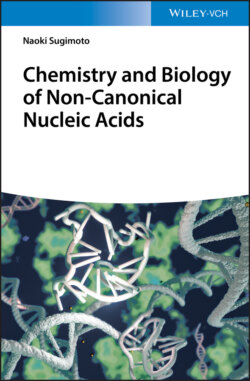Читать книгу Chemistry and Biology of Non-canonical Nucleic Acids - Naoki Sugimoto - Страница 36
2.6.3.2 Ribose Zipper
ОглавлениеRibose zipper is also widely used interaction in RNA tertiary structures [24a]. It is usually characterized by two consecutive residues at one segment interact with two consecutive residues from another segment distant in the sequence through hydrogen bonding involving their 2′-hydroxy groups. Various classes of the ribose zipper interactions were proposed depending on the hydrogen bonding patterns [27]. In almost of the ribose zipper classes, two interacting RNA strands are in antiparallel orientation. The ribose zipper motif is often observed with other tertiary interactions such as A-minor interaction and GNRA tetraloop receptor interaction, which is described later (Section 2.6.3.5). For example, crystal structure of group I intron [28], one of the tertiary structures from which ribose zipper interactions were proposed, contains bulge–helix and loop–helix interactions involving the ribose zipper interaction (Figure 2.13). Both of which are associated with A-minor interaction or GAAA tetraloop receptor interaction. Since the contribution of the ribose zipper interaction on the stability of RNA tertiary structure is weaker than other tertiary interaction motifs [26, 29], as well as the A-minor interaction, ribose zipper interactions are considered to have roles supporting tertiary interactions. However, it is also considered that the ribose zipper interaction, which is provided by the 2′-hydroxy group unique for RNA ribose, is one of the indispensable factors to form complexed structures of RNAs.
Figure 2.13 Ribose zipper interactions in tertiary structure of group I intron derived from Tetrahymena thermophila (PDBID: 1GID). Overall tertiary structure (a) and enlarged images of different types of two ribose zipper interactions (b) are shown. Hydrogen bonds involved in the ribose zipper interactions are shown in dashed lines. Arrows show orientation of RNA strands.
